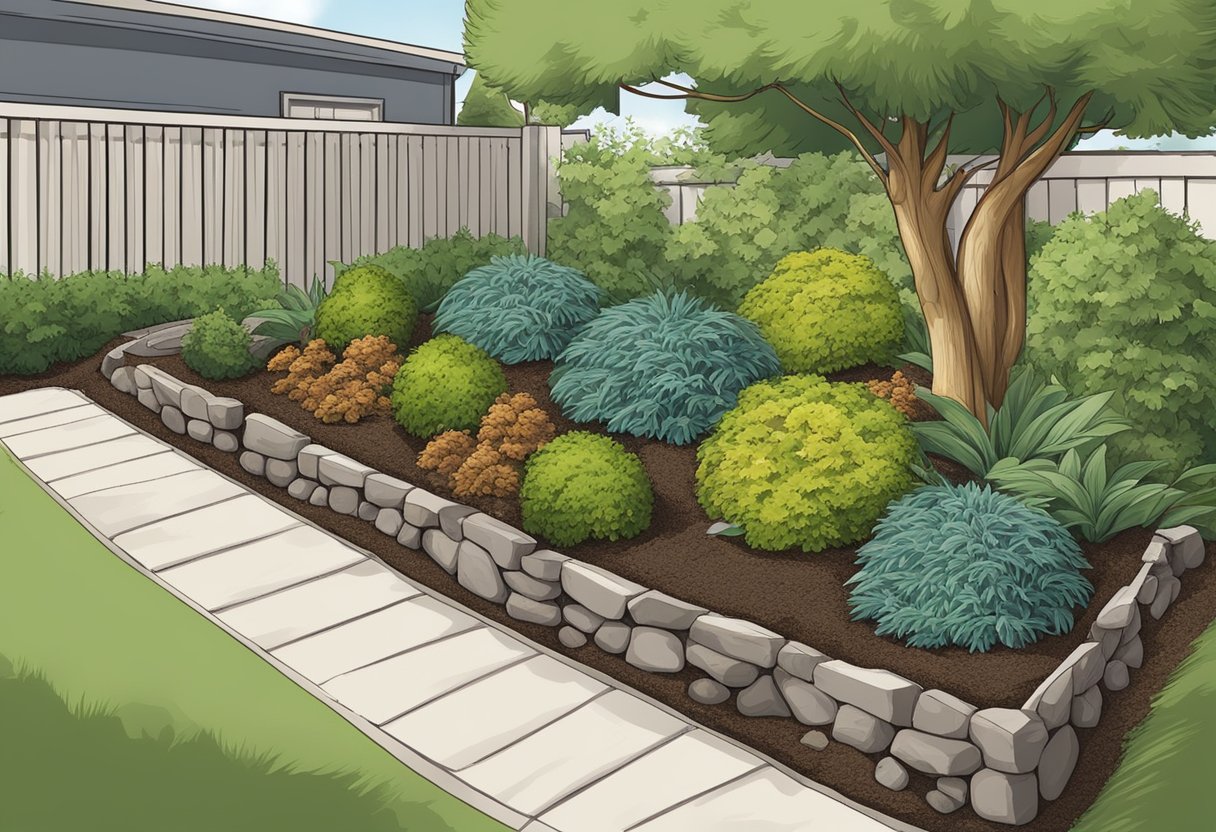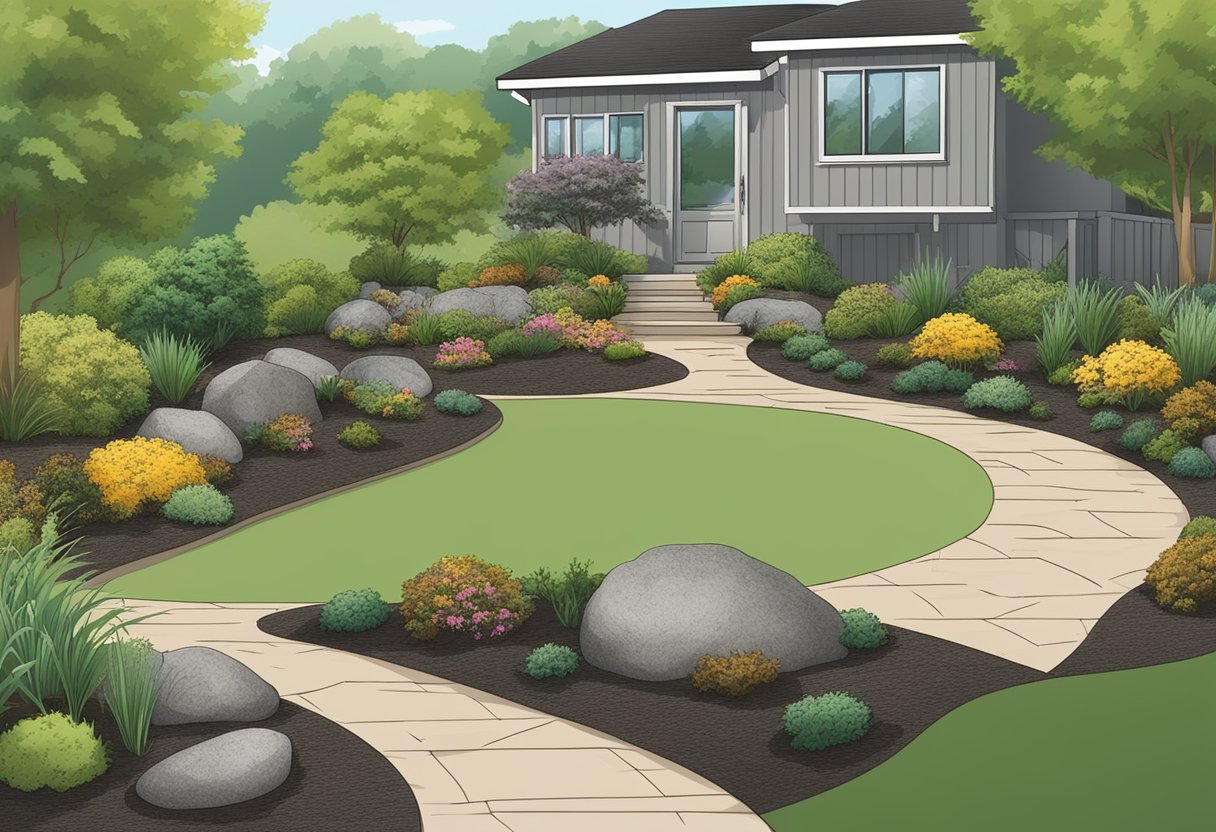Applying mulch over rocks in landscaping is a practical gardening technique that we often recommend for various reasons.
By layering mulch atop rocks, we find that not only is the aesthetic appeal of the garden enhanced, but the functional benefits are significant as well.
Mulch helps in retaining moisture in the soil, reduces weed growth, and can even protect plant roots from temperature extremes.
The rocks underneath serve as a solid moisture and weed barrier, improving drainage and adding another layer of insulation against weather that is too hot or cold.

Our collective experience informs us that when mulching over rocks, it’s important to ensure the rock bed is level and that a layer of landscaping fabric is used between the mulch and rocks.
This fabric acts as an essential separator that keeps the mulch from mixing with the rocks beneath, making maintenance tasks like updating or replacing mulch much easier.
By combining rocks and mulch, we effectively marry the advantages of both: rocks for their permanence and mulch for its organic benefits, adding unrivaled value to our landscaping projects.
Benefits and Considerations

Before we explore the intricate balance between the benefits and the possible drawbacks of placing mulch over rocks, let’s highlight the key factors of this landscaping practice.
Our focus will be on soil health, garden aesthetics, and overall plant growth.
Advantages of Mulching Over Rocks
Mulching directly on top of landscaping rocks can offer several advantages for garden maintenance and aesthetics:
- Moisture Retention: Mulch helps to retain moisture in the soil, which is beneficial for plant growth.
- Weed Control: Mulch acts as a barrier to weed seeds, reducing the amount of weed growth.
- Insulation from Heat: It provides insulation, protecting plant roots from extreme temperatures.
- Adding Organic Matter: Organic mulches decompose over time, adding valuable nutrients to the soil and improving soil structure.
Challenges and Drawbacks
However, there are challenges and potential drawbacks when mulching over rocks that we need to consider:
- Risk of Soil Erosion: Heavy rains can displace the mulch, leading to soil erosion.
- Pests and Termites: Organic mulches can attract pests, such as termites, which could be detrimental to the landscape.
- Disturbing Drainage: Depending on the existing rock and mulch type, drainage could be impeded, affecting plant health.
- Altering pH Levels: Some mulches can change the pH of the soil, which may negatively impact sensitive plants.
- Increased Maintenance: Layers of decomposing mulch over rocks may require more frequent replacement compared to rocks alone.
How-to Guide for Mulching Over Rocks

When mulching over rocks in your yard or flower bed, it’s crucial to ensure proper preparation, select the right mulch, and commit to regular maintenance. This ensures weed suppression, adds visual interest, and supports soil health even in hot summer months.
Preparation and Removal of Rocks
Before introducing mulch, we must prepare the area to enhance the soil quality and ensure the longevity of our work.
- Clear Debris: Use a rake or hands to remove leaves, grass clippings, and other debris from the rock surface.
- Rocks Assessment: Decide which rocks will stay—consider removing sharp or overly large rocks that could pierce the landscaping fabric or inhibit mulch application.
- Install Landscaping Fabric: Lay a breathable fabric over the rocks to prevent weed growth while allowing water and nutrients to reach the soil.
Selection and Application of Mulch
Choosing the right mulch type and applying it accurately is vital for plant health and yard aesthetics.
- Types of Mulch: Select an organic mulch like wood chips, bark, compost, or pine needles for nutrient-rich soil, or choose inorganic mulch like rock or rubber for longer-lasting results.
- Application: Spread a mulch layer of at least 2 inches with a shovel or by hand, ensuring it’s even and extends to the edging of your flower beds or yard for a tidy appearance.
Maintenance and Upkeep
To maintain the benefits of mulching over rocks, such as moisture retention and temperature regulation, regular upkeep is necessary.
- Refresh Mulch Annually: Replenish organic mulch each spring to compensate for natural decomposition and to maintain a vibrant appearance.
- Weed and Soil Monitoring: Periodically check for weeds and gently aerate the mulch to encourage airflow, which benefits soil microbes and plant roots.
- Inspection: After heavy rains, inspect the mulch layer for erosion or displacement and adjust as needed to protect plant health.